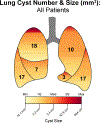Prevalence of lung cysts in adolescents and adults with a germline DICER1 pathogenic/likely pathogenic variant: a report from the National Institutes of Health and International Pleuropulmonary Blastoma/ DICER1 Registry
- PMID: 38508719
- PMCID: PMC11179973
- DOI: 10.1136/thorax-2023-221024
Prevalence of lung cysts in adolescents and adults with a germline DICER1 pathogenic/likely pathogenic variant: a report from the National Institutes of Health and International Pleuropulmonary Blastoma/ DICER1 Registry
Abstract
Background: Pleuropulmonary blastoma (PPB), the hallmark tumour associated with DICER1-related tumour predisposition, is characterised by an age-related progression from a cystic lesion (type I) to a high-grade sarcoma with mixed cystic and solid features (type II) or purely solid lesion (type III). Not all cystic PPBs progress; type Ir (regressed), hypothesised to represent regressed or non-progressed type I PPB, is an air-filled, cystic lesion lacking a primitive sarcomatous component. This study aims to evaluate the prevalence of non-progressed lung cysts detected by CT scan in adolescents and adults with germline DICER1 pathogenic/likely pathogenic (P/LP) variants.
Methods: Individuals were enrolled in the National Cancer Institute Natural History of DICER1 Syndrome study, the International PPB/DICER1 Registry and/or the International Ovarian and Testicular Stromal Tumor Registry. Individuals with a germline DICER1 P/LP variant with first chest CT at 12 years of age or older were selected for this analysis.
Results: In the combined databases, 110 individuals with a germline DICER1 P/LP variant who underwent first chest CT at or after the age of 12 were identified. Cystic lung lesions were identified in 38% (42/110) with a total of 72 cystic lesions detected. No demographic differences were noted between those with lung cysts and those without lung cysts. Five cysts were resected with four centrally reviewed as type Ir PPB.
Conclusion: Lung cysts are common in adolescents and adults with germline DICER1 variation. Further study is needed to understand the mechanism of non-progression or regression of lung cysts in childhood to guide judicious intervention.
Keywords: Imaging/CT MRI etc; Lung Cancer; Paediatric Lung Disaese; Rare lung diseases.
© Author(s) (or their employer(s)) 2024. No commercial re-use. See rights and permissions. Published by BMJ.
Conflict of interest statement
Competing interests: Dr Hill is the owner of ResourcePath LLC, a company which does research and development of laboratory tests including for DICER1-related cancers. The work is unrelated to the information presented in this article. Dr Stewart provides telegenetics services for Genome Medical, Inc, in accordance with relevant National Cancer Institute policies. The remaining authors have no conflicts to disclose.
Figures




Similar articles
-
Outcomes in ovarian Sertoli-Leydig cell tumor: A report from the International Pleuropulmonary Blastoma/DICER1 and Ovarian and Testicular Stromal Tumor Registries.Gynecol Oncol. 2024 Jul;186:117-125. doi: 10.1016/j.ygyno.2024.04.005. Epub 2024 Apr 23. Gynecol Oncol. 2024. PMID: 38657450 Free PMC article.
-
Prognostic Significance of Germline DICER1 Pathogenic or Likely Pathogenic Variants in Outcomes of Ovarian Sertoli-Leydig Cell Tumor.JCO Precis Oncol. 2025 Apr;9:e2400902. doi: 10.1200/PO-24-00902. Epub 2025 Apr 23. JCO Precis Oncol. 2025. PMID: 40267387
-
Pleuropulmonary blastoma: a report on 350 central pathology-confirmed pleuropulmonary blastoma cases by the International Pleuropulmonary Blastoma Registry.Cancer. 2015 Jan 15;121(2):276-85. doi: 10.1002/cncr.29032. Epub 2014 Sep 10. Cancer. 2015. PMID: 25209242 Free PMC article.
-
Multimorbidity and Genetic Characteristics of DICER1 Syndrome Based on Systematic Review.J Pediatr Hematol Oncol. 2017 Jul;39(5):355-361. doi: 10.1097/MPH.0000000000000715. J Pediatr Hematol Oncol. 2017. PMID: 27906793
-
Nutritional interventions for survivors of childhood cancer.Cochrane Database Syst Rev. 2016 Aug 22;2016(8):CD009678. doi: 10.1002/14651858.CD009678.pub2. Cochrane Database Syst Rev. 2016. PMID: 27545902 Free PMC article.
Cited by
-
DICER1-Related Tumor Predisposition: Identification of At-risk Individuals and Recommended Surveillance Strategies.Clin Cancer Res. 2024 Dec 16;30(24):5681-5692. doi: 10.1158/1078-0432.CCR-24-1532. Clin Cancer Res. 2024. PMID: 39400264 Free PMC article.
-
Pleuropulmonary blastoma and DICER1-related tumor predisposition: from clinicopathologic observations to clinical trial.Curr Opin Pediatr. 2025 Feb 1;37(1):48-55. doi: 10.1097/MOP.0000000000001431. Epub 2024 Dec 6. Curr Opin Pediatr. 2025. PMID: 39699100 Review.
-
Brain metastasis of pleuropulmonary blastoma: case reports.Transl Pediatr. 2025 Mar 31;14(3):480-486. doi: 10.21037/tp-24-341. Epub 2025 Mar 26. Transl Pediatr. 2025. PMID: 40225067 Free PMC article.
-
Update on Pediatric Surveillance Recommendations for PTEN Hamartoma Tumor Syndrome, DICER1-Related Tumor Predisposition, and Tuberous Sclerosis Complex.Clin Cancer Res. 2025 Jan 17;31(2):234-244. doi: 10.1158/1078-0432.CCR-24-1947. Clin Cancer Res. 2025. PMID: 39540884 Free PMC article. Review.
References
Publication types
MeSH terms
Substances
Supplementary concepts
Grants and funding
LinkOut - more resources
Full Text Sources
Research Materials
